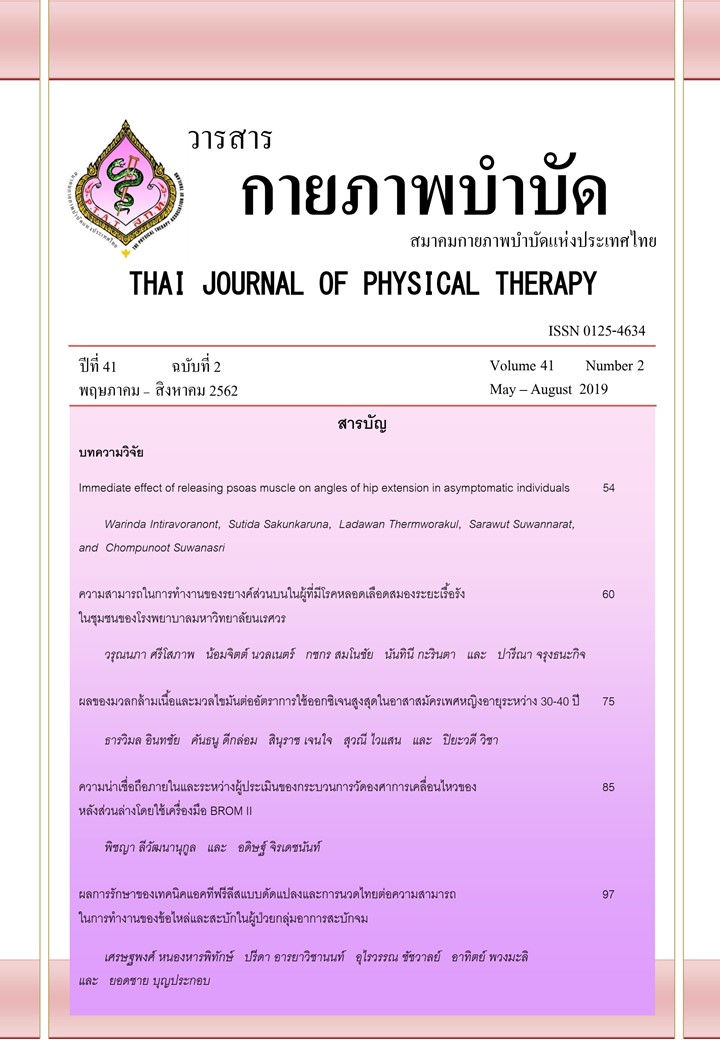ผลของมวลกล้ามเนื้อและมวลไขมันต่ออัตราการใช้ออกซิเจนสูงสุดในอาสาสมัครเพศหญิงอายุระหว่าง 30-40 ปี
Main Article Content
บทคัดย่อ
ที่มาและความสำคัญ: การศึกษาที่ผ่านมาพบว่า อัตราการใช้ออกซิเจนสูงสุด เป็นค่าที่ใช้ประเมินความสามารถในการสร้างพลังงานแบบแอโรบิค ขณะออกกำลังกายหรือการทำกิจวัตรประจำวันต่างๆ แต่การศึกษาผลและความสัมพันธ์ของดัชนีมวลกาย มวลไขมันและมวลกล้ามเนื้อต่ออัตราการใช้ออกซิเจนสูงสุด ในอาสาสมัครเพศหญิงที่ไม่ค่อยออกกำลังกายอายุระหว่าง 30- 40 ปียังมีจำนวนจำกัด
วัตถุประสงค์: การศึกษานี้มีวัตถุประสงค์เพื่อ 1) เปรียบเทียบอัตราการใช้ออกซิเจนสูงสุด ในอาสาสมัครหญิงที่ไม่ค่อยออกกำลังกาย ที่มีดัชนีมวลกายปกติ (18.5-22.9 กิโลกรัม/ตารางเมตร) จำนวน 20 คน และอาสาสมัครที่มีดัชนีมวลกายน้อยกว่าปกติ (< 18.5 กิโลกรัม/ตารางเมตร) จำนวน 20 คน 2) เพื่อศึกษาปัจจัยที่มีผลต่ออัตราการใช้ออกซิเจนสูงสุด ในอาสาสมัครหญิงที่ไม่ค่อยออกกำลังกาย อายุระหว่าง 30-40 ปี
วิธีการวิจัย: อาสาสมัครถูกมวลไขมันและมวลของร่างกายที่ปราศจากไขมัน อัตราการใช้ออกซิเจนสูงสุด โดยการทดสอบปั่นจักรยานวัดงาน ข้อมูลทั้งหมดจะถูกเปรียบเทียบความแตกต่างระหว่างอาสาสมัครทั้งสองกลุ่ม ด้วยสถิติ independent t-test และหาค่าสัมประสิทธิ์สหสัมพันธ์พหุคูณ ด้วยการวิเคราะห์การถดถอยเชิงเส้นพหุคูณ โดยกำหนดนัยสำคัญทางสถิติที่ 0.05
ผลการวิจัย: อาสาสมัครหญิงที่มีดัชนีมวลกายน้อยกว่าเกณฑ์ปกติ ที่มีมวลกล้ามเนื้อมาก มีอัตราการใช้ออกซิเจนสูงสุดมากกว่าอาสาสมัครหญิงที่มีดัชนีมวลกายอยู่ในเกณฑ์ปกติ ที่มีมวลไขมันมาก ค่าน้ำหนักของปัจจัยที่สามารถร่วมกันพยากรณ์อัตราการใช้ออกซิเจนสูงสุดอย่างมีนัยสำคัญทางสถิติที่ระดับ 0.001 ดัชนีมวลกาย มวลไขมันและมวลกล้ามเนื้อ มีค่าสัมประสิทธิ์ของตัวแปรพยากรณ์ในรูปคะแนนมาตรฐาน (β) เท่ากับ -0.264, -0.374 และ 0.470 ตามลำดับ มีอำนาจในการพยากรณ์ร้อยละ 74.1 ค่าความคาดเคลื่อนมาตรฐานเท่ากับ 2.79
สรุปผล: มวลกล้ามเนื้อและไขมัน มีผลต่ออัตราการใช้ออกซิเจนสูงสุดมากกว่าดัชนีมวลกาย กลุ่มคนที่มีพฤติกรรมไม่ค่อยออกกำลังกายอายุระหว่าง 30-40 ปี ควรเน้นการเพิ่มมวลกล้ามเนื้อ และลดมวลไขมันในร่างกาย เพื่อคงสมรรถภาพทางกาย
Article Details
เอกสารอ้างอิง
2. Nelson MD, Petersen SR, Dlin RA. Effects of age and counseling on the cardiorespiratory response to graded exercise. Med Sci Sports Exerc. 2010;42(2):255-64.
3. Onofre T, Oliver N, Carlos R, Felismino A, Corte RC, Silva E, et al. Oxygen uptake efficiency slope as a useful measure of cardiorespiratory fitness in morbidly obese women. PLoS One. 2017;12(4):e0172894.
4. Mondal H, Mishra SP. Effect of BMI, Body Fat Percentage and Fat Free Mass on Maximal Oxygen Consumption in Healthy Young Adults. J Clin Diagn Res. 2017;11(6):CC17-CC20.
5. Azad A, Zamani A. Lean body mass can predict lung function in underweight and normal weight sedentary female young adults. Tanaffos. 2014;13(2):20-6.
6. Kostrzewa Nowak D, Nowak R, Jastrzebski Z, Zarebska A, Bichowska M, Drobnik-Kozakiewicz I, et al. Effect of 12-week-long aerobic training programme on body composition, aerobic capacity, complete blood count and blood lipid profile among young women. Biochem Med (Zagreb). 2015;25(1):103-13.
7. Kenny GP, Groeller H, McGinn R, Flouris AD. Age, human performance, and physical employment standards. Appl Physiol Nutr Metab. 2016;41(6 Suppl 2):S92-S107.
8. Sehl ME, Yates FE. Kinetics of human aging: I. Rates of senescence between ages 30 and 70 years in healthy people. J Gerontol A Biol Sci Med Sci. 2001;56(5):B198-208.
9. Booth FW, Roberts CK, Laye MJ. Lack of exercise is a major cause of chronic diseases. Compr Physiol. 2012;2(2):1143-211.
10. Rollero C, De Piccoli N. Self-Objectification and Personal Values. An Exploratory Study. Front Psychol. 2017;8:1055.
11. Gallagher D, Heymsfield SB, Heo M, Jebb SA, Murgatroyd PR, Sakamoto Y. Healthy percentage body fat ranges: an approach for developing guidelines based on body mass index. Am J Clin Nutr. 2000;72(3):694-701.
12. Jirawatkul A. Statistics for health science research. Bangkok: Wittayapat company; 2009.
13. Regima S, Balakrishnan R, Thanabalan K. Effect of body mass index on the VO₂max in female AMU students. Int j phys educ sports health. 2016;3(1):272-6.
14. Stegenga H, Haines A, Jones K, Wilding J, Guideline Development G. Identification, assessment, and management of overweight and obesity: summary of updated NICE guidance. BMJ. 2014;349:g6608.
15. Duren DL, Sherwood RJ, Czerwinski SA, Lee M, Choh AC, Siervogel RM, et al. Body composition methods: comparisons and interpretation. J Diabetes Sci Technol. 2008;2(6):1139-46.
16. Cabrera de Leon A, Rodriguez-Perez Mdel C, Rodriguez-Benjumeda LM, Ania-Lafuente B, Brito-Diaz B, Muros de Fuentes M, et al. [Sedentary lifestyle: physical activity duration versus percentage of energy expenditure]. Rev Esp Cardiol. 2007;60(3):244-50.
17. Pereira C, Silva RAD, de Oliveira MR, Souza RDN, Borges RJ, Vieira ER. Effect of body mass index and fat mass on balance force platform measurements during a one-legged stance in older adults. Aging Clin Exp Res. 2018;30(5):441-7.
18. Cink RE, Thomas TR. Validity of the Astrand-Ryhming nomogram for predicting maximal oxygen intake. Br J Sports Med. 1981;15(3):182-5.
19. Kanae Oda, Nobuyuki Miyatake, Noriko Sakano, Takeshi Saito, Motohiko Miyachi, Izumi Tabata, et al. Relationship between peak oxygen uptake and regional body composition in Japanese subjects. J Sport Health Sci. 2014;3(3):233-8.
20. Hawkins MN, Raven PB, Snell PG, Stray-Gundersen J, Levine BD. Maximal oxygen uptake as a parametric measure of cardiorespiratory capacity. Med Sci Sports Exerc. 2007;39(1):103-7.
21. Kim DK. Accuracy of predicted resting metabolic rate and relationship between resting metabolic rate and cardiorespiratory fitness in obese men. J Exerc Nutrition Biochem. 2014;18(1):25-30.
22. Santa-Clara H, Szymanski L, Ordille T, Fernhall B. Effects of exercise training on resting metabolic rate in postmenopausal African American and Caucasian women. Metabolism. 2006;55(10):1358-64.
23. Maciejczyk M, Wiecek M, Szymura J, Szygula Z, Wiecha S, Cempla J. The influence of increased body fat or lean body mass on aerobic performance. PLoS One. 2014;9(4):e95797.
24. Thivel D, Metz L, Aucouturier J, Brakoniecki K, Duche P, Morio B. The effects of imposed sedentary behavior and exercise on energy intake in adolescents with obesity. J Dev Behav Pediatr. 2013;34(8):616-22.
25. Fletcher G, Eves FF, Glover EI, Robinson SL, Vernooij CA, Thompson JL, et al. Dietary intake is independently associated with the maximal capacity for fat oxidation during exercise. Am J Clin Nutr. 2017;105(4):864-72.
26. Shete AN, Bute SS, Deshmukh PR. A Study of VO2 Max and Body Fat Percentage in Female Athletes. J Clin Diagn Res. 2014;8(12):BC01-3.
27. Frost EA, Redman LM, de Jonge L, Rood J, Zachwieja JJ, Volaufova J, et al. Interaction between dietary fat and exercise on excess postexercise oxygen consumption. Am J Physiol Endocrinol Metab. 2014;306(9):E1093-8.


